【期末备考】2023-2024学年度人教新目标版七年级上册英语期末质量监测解题策略指导课件
文档属性
| 名称 | 【期末备考】2023-2024学年度人教新目标版七年级上册英语期末质量监测解题策略指导课件 |  | |
| 格式 | pptx | ||
| 文件大小 | 2.6MB | ||
| 资源类型 | 试卷 | ||
| 版本资源 | 人教新目标(Go for it)版 | ||
| 科目 | 英语 | ||
| 更新时间 | 2024-01-17 17:15:17 | ||
图片预览

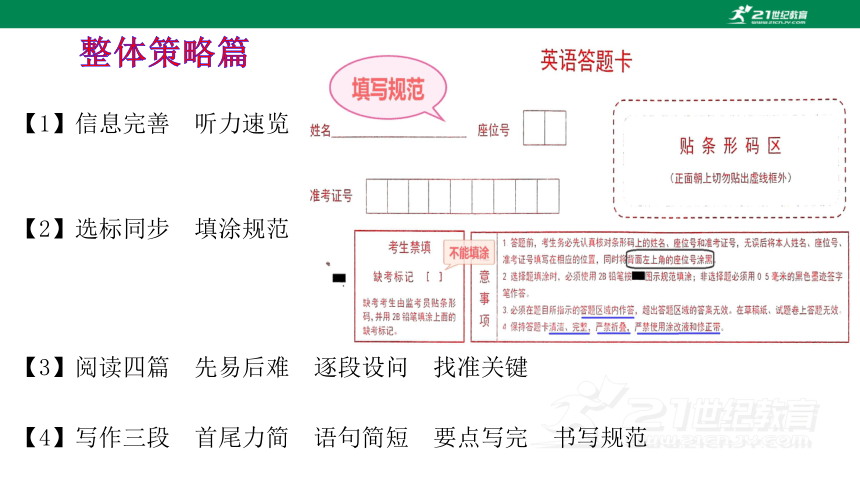
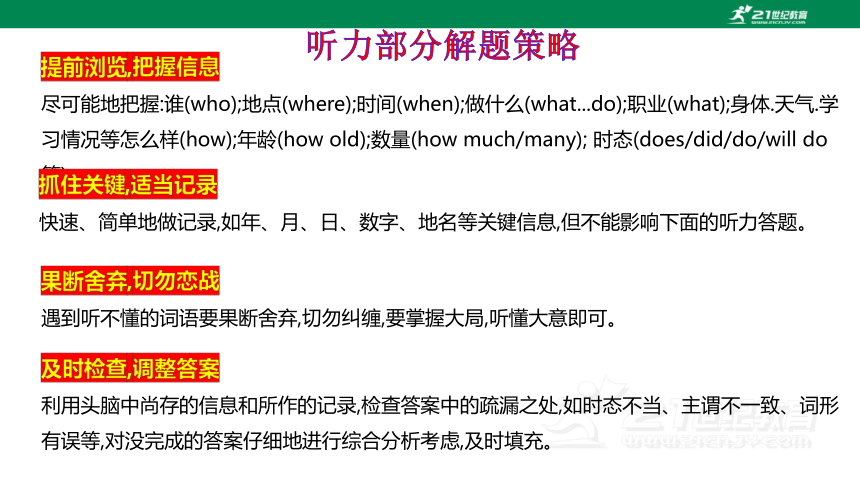


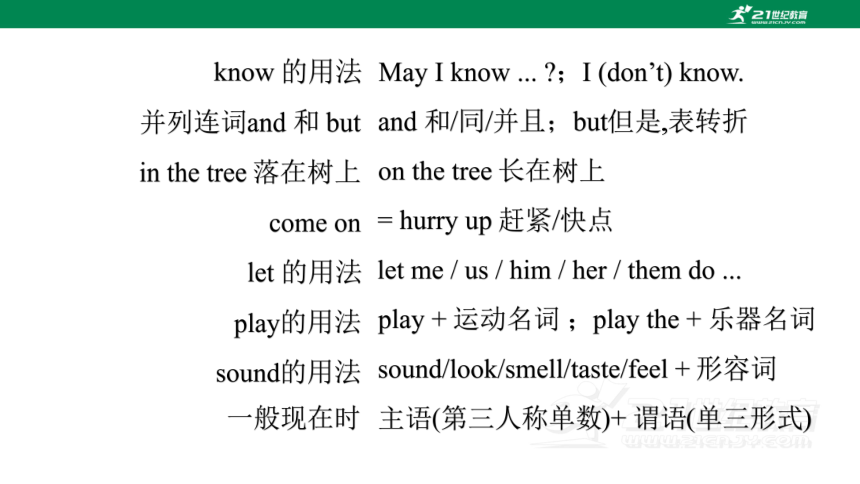
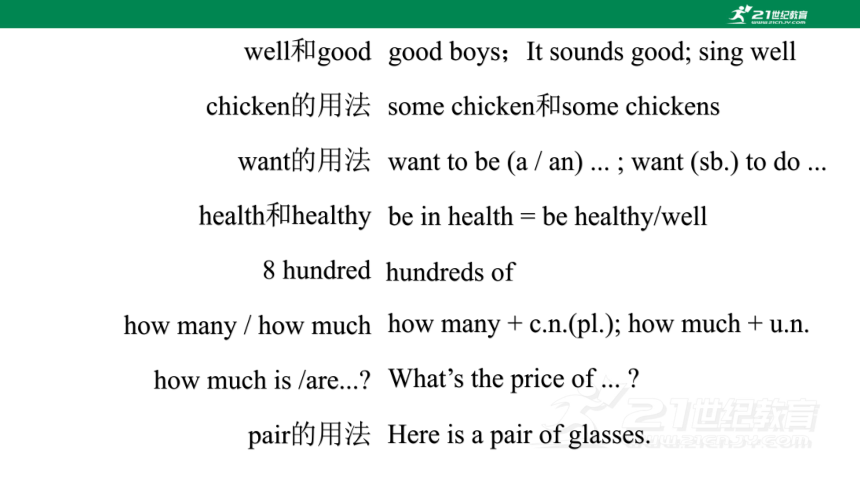
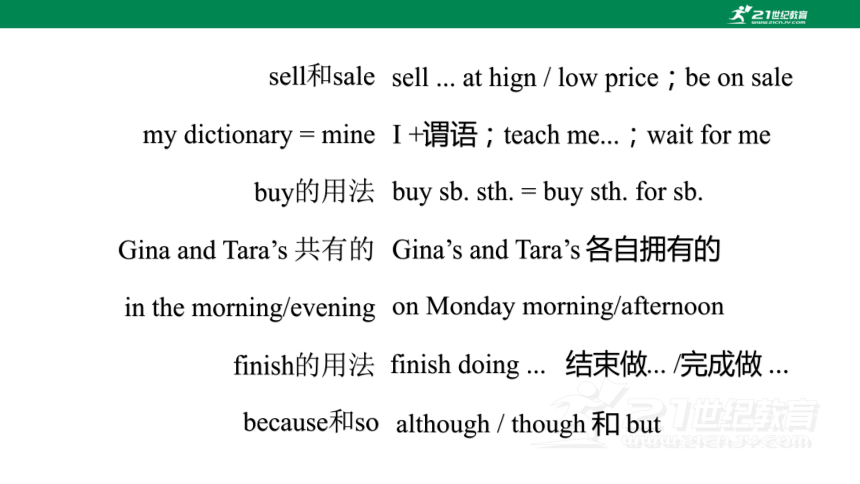

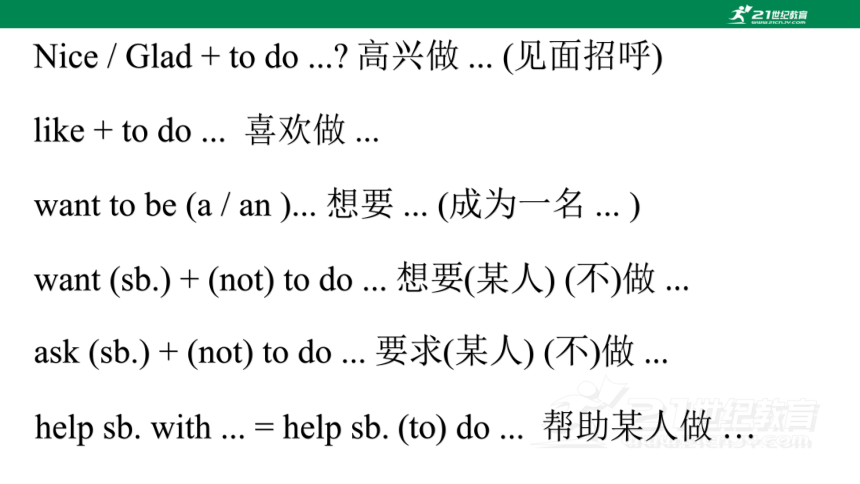
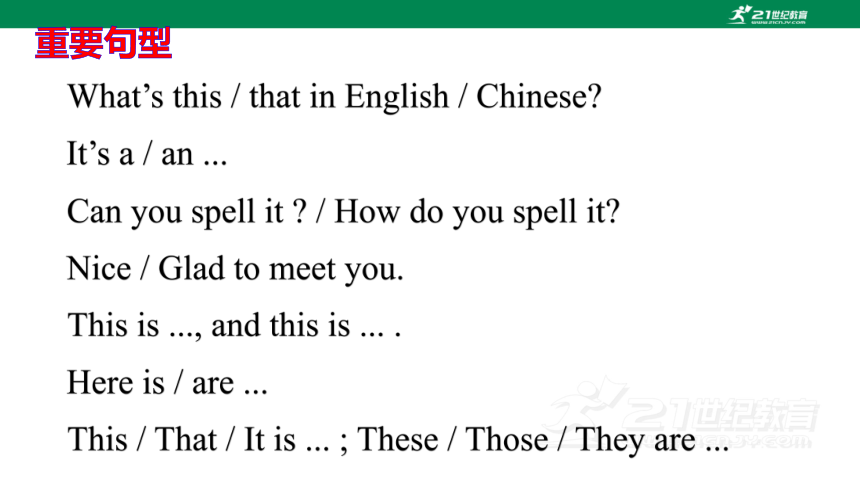
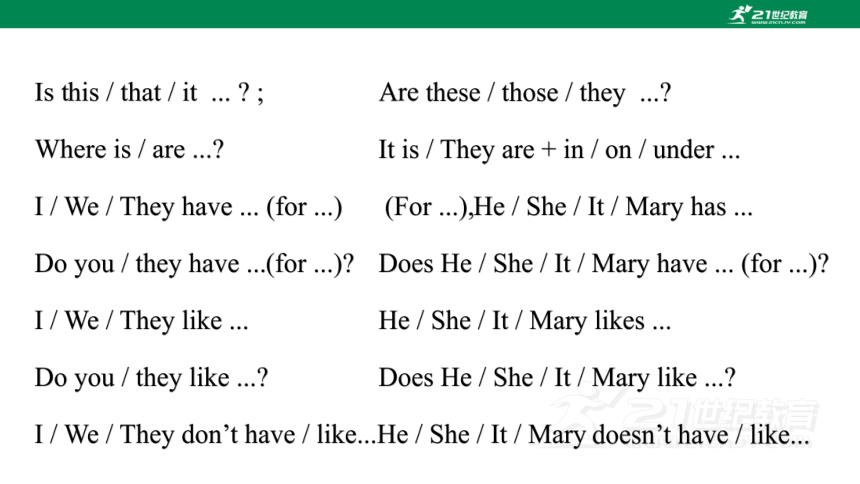
文档简介
(共39张PPT)
解题策略指导
人教新目标版七年级上册
2023-2024年期末英语质量监测
整体策略篇
【1】信息完善 听力速览
【2】选标同步 填涂规范
【3】阅读四篇 先易后难 逐段设问 找准关键
【4】写作三段 首尾力简 语句简短 要点写完 书写规范
听力部分解题策略
提前浏览,把握信息
尽可能地把握:谁(who);地点(where);时间(when);做什么(what...do);职业(what);身体.天气.学习情况等怎么样(how);年龄(how old);数量(how much/many); 时态(does/did/do/will do 等)。
抓住关键,适当记录
快速、简单地做记录,如年、月、日、数字、地名等关键信息,但不能影响下面的听力答题。
果断舍弃,切勿恋战
遇到听不懂的词语要果断舍弃,切勿纠缠,要掌握大局,听懂大意即可。
及时检查,调整答案
利用头脑中尚存的信息和所作的记录,检查答案中的疏漏之处,如时态不当、主谓不一致、词形有误等,对没完成的答案仔细地进行综合分析考虑,及时填充。
am, is,are用法
a+(辅音音素), an+(元音音素)
定冠词the的用法
first name与last name
形物代和名物代
of 的用法
here的用法
a set of keys / a pair of shoes 作主语当单数
an unhappy day;a useful way
序数最高专有独,乐器类别逢十复
last name= family name Mr. / Mrs. / Ms.
有名则形;无名则名
a picture / photo of... ; the name of...
here is / are ...; Here you are.
who的用法
Who is he / she /it ;Who are they
常见考点梳理
This is + 姓名(电话用语)我是...
What / How about的用法
ask的用法
some的用法
thanks / Thank you for...
call 和emai
where问地点
Is that + 姓名?(电话用语)你是...?
What / How about + n. / doing
ask sb. (not) to do ... ;ask ... for...
some 肯定句;any 否定句或疑问句
Thanks / thank you for + n. / doing ...
call / email at ...
主语 + be + in / on / under ...
指示代词this,that,these,those
Yes,it is. No, they aren’t.
in the tree 落在树上
come on
let 的用法
play的用法
sound的用法
一般现在时
on the tree 长在树上
= hurry up 赶紧/快点
let me / us / him / her / them do ...
play + 运动名词 ;play the + 乐器名词
sound/look/smell/taste/feel + 形容词
主语(第三人称单数)+ 谓语(单三形式)
并列连词and 和 but
and 和/同/并且;but但是,表转折
know 的用法
May I know ... ;I (don’t) know.
health和healthy
8 hundred
how many / how much
how much is /are...
pair的用法
be in health = be healthy/well
hundreds of
how many + c.n.(pl.); how much + u.n.
What’s the price of ...
Here is a pair of glasses.
want的用法
want to be (a / an) ... ; want (sb.) to do ...
well和good
good boys;It sounds good; sing well
chicken的用法
some chicken和some chickens
in the morning/evening
finish的用法
because和so
on Monday morning/afternoon
finish doing ... 结束做... /完成做 ...
although / though 和 but
Gina and Tara’s 共有的
Gina’s and Tara’s 各自拥有的
sell和sale
my dictionary = mine
sell ... at hign / low price;be on sale
I +谓语;teach me...;wait for me
buy的用法
buy sb. sth. = buy sth. for sb.
what / how about + doing ... 做... 怎样?(提建议)
固定搭配
think about + doing ... 考虑做 ...
finish + doing ... 结束 / 完成做 ...
like + doing ... 喜欢做 …
be good at + doing ... 擅长做 … / 特长做 ...
Thanks for + doing …感谢做 …
be busy with ... = be busy doing 忙于做 ...
Nice / Glad + to do ... 高兴做 ... (见面招呼)
like + to do ... 喜欢做 ...
want to be (a / an )... 想要 ... (成为一名 ... )
want (sb.) + (not) to do ... 想要(某人) (不)做 ...
ask (sb.) + (not) to do ... 要求(某人) (不)做 ...
help sb. with ... = help sb. (to) do ... 帮助某人做 …
What’s this / that in English / Chinese
It’s a / an ...
Can you spell it / How do you spell it
Nice / Glad to meet you.
This is ..., and this is ... .
Here is / are ...
This / That / It is ... ; These / Those / They are ...
重要句型
Is this / that / it ... ; Are these / those / they ...
Where is / are ... It is / They are + in / on / under ...
I / We / They have ... (for ...) (For ...),He / She / It / Mary has ...
Do you / they have ...(for ...) Does He / She / It / Mary have ... (for ...)
I / We / They like ... He / She / It / Mary likes ...
Do you / they like ... Does He / She / It / Mary like ...
I / We / They don’t have / like...He / She / It / Mary doesn’t have / like...
Can I help you What can I do for you
We have ... in purple / red ... We have purple / red ...
We sell ... at high / low e and buy ... at our great sale.
How much is /are ... What’s the price of ...
We have ... for $28. $3 for two pairs
I’ll take ...
When is your birthday My birthday is in July / on July 6th.
Happy Birthday! Thank you!
Happy New Year! You,too! / The same to you!
Do you want to come to my birthday party
We have some interesting and fun things for you this term.
We have a book sale in the school library at 3:00 on Monday afternoons.
Have a good time / morning...! You,too! / The same to you!
How’s your grandfather / your day / the weather
I think history is boring. I don’t think history is boring.
I like Wednesday because I have an art lesson.
He always paly games with me / us / her / them.
We have some interesting and fun things for you this term.
Why do you like ... Because ...
That’s for sure.
谁 + 干什么 / 是什么 / 怎么样 + 时间 / 地点 / 方式
时间 / 地点 / 方式 ,谁 + 干什么 / 是什么 / 怎么样
It is + adj. + (for / of sb.) + to do ... 对于...来说,做某事是 ...样的。
Doing ... is + adj.
Here is a photo / picture of ...
as+原级+ as & not+so/as+原级+as
比较级 + than
比较级+ and +比较级 越来越...
the +比较级, the + 比较级 越...就越...
Who is + 比较级,A or B
最高级 + of / in ...
Who is + the 最高级,A,B or C
完形填空解题策略
根据上下文寻找线索
多数空格的线索就在上下两三行中,需要仔细读题,关注文章中出现的每个细节。
根据语法规则寻找答案
动词的时态(时态标志词);固定搭配;介词
根据固定搭配解题
通过句子的完整性或句子后面的标点来判断该句子在文章中的位置。
根据固定句型结构解题
“How+adj,/adv,+主语+谓语!”
寻找关键词,并锁定与之相关的词汇
通篇文章反复出现同一个词汇,或者全文有一个非常核心的主题,那么这个词汇或者与这个主题相关的词汇都很有可能成为要选择的答案。
细节理解题应试策略
主要设问方式
Which of the following is right/TRUE/NOTTURE/isn't mentioned(提到)
The following are all right EXCEPT(除了 ... 以外 ...) .
Which of the following is the right order(正确的顺序)
What can we learn about(获得)..
用What/Which/When/Where/Why/How等引导的特殊疑问句。
解题技巧
① 关键词定位法。读懂题干,通过题干信息确定关键词,利用信息定位,快速在文中找到符合题干内容的原句,提取答案。
② 同义转换法。根据题干中的关键词,在文章中寻找相关段落与句子时,要注意题干、选项可能存在和原文有同义/近义/反义词转换或词性,语态有所变化的情况。
词义猜测题应试策略
主要设问方式
① What's the meaning of the underlined word/phrase.. in Chinese
② What does... most probably mean in Chinese
③ What does the word... refer to
④ What does the underlined sentence.. probably mean
词义猜测题应试策略
解题技巧
① 根据上下文语境猜测词义。仔细阅读生词前后的语句,分析已知信息与生词之间的关系;
② 通过定义、释义关系或举例猜测词义。重点关注that is (to say),in other words, be called, be considered to be 等词汇或破折号、冒号;
③ 通过构词法猜测词义。常用的词根、前缀、后缀等构词法知识;
④ 通过逻辑关系猜测词义。找出生词与上下文之间的逻辑关系(因果、转折、并列、对比等)推断;
⑤ 利用基础的科普知识和生活常识,结合上下文来推测其含义。
推理判断题应试策略
主要设问方式
① What's the purpose of the passage
② What's the writer's main purpose in writing this passage
③ The purpose of this passage is to .
④ What is the writer trying to do in this passage
⑤ The writer wants to tell us that
⑥ What can we lean from the passage
⑦ From the passage, we can know .
⑧ The passage is a page from .
推理判断题应试策略
解题技巧
① 依据题干中的关键词在原文中定位,然后根据原文内容进行正确的推理和判断。
② 根据文章的结论推断作者的观点、态度和写作意图。在阅读文章时要重点理解首尾段,推断作者的观点。
③ 做推理判断题时,有时需要在弄懂全文意思的基础上,整合与题目相关的有用信息,综合起来去推理判断。
④ 根据文章的内容、体裁或结构来推断文章的出处。
主旨大意题应试策略
主要设问方式
① What's the main idea of this passage/Paragraph 2
② What does the passage mainly tell us
③ What is the passage mainly about
④ What does the writer mainly tell us
⑤ What can we learn from the whole passage
⑥ The last paragraph is chiefly concerned with .
⑦ What's the best title for the passage
⑧ Which of the following would be the best title for the passage
阅读理解主旨大意题应试策略
解题技巧
①留心关键词,关键词即文中反复出现的、与主题有关的名词或动词等实词或强调的信息。
②找准主题句,主题句是表示全文或段落中心思想的句子,它表明作者的观点、态度、目的等。
③选项中如果出现绝对化用词(never, any, all, impossible, none, most, primarily...),或仅仅提到文章中的某一点或某一部分,这类选项作为文章的主旨大意会太过绝对或片面,通常不选。
注意代词或定冠词
通过代词在句子中所作的成份,我们可以推断出其指代句子的型。
补全短文解题策略
考查学生的综合能力,在读懂文章大意基础上,会分析文章的结构,句子间的内在逻辑等。
读选项中的句子
通过句子的完整性或句子后面的标点来判断该句子在文章中的位置。
观察空格的前后
通过选项中某个名词或动词跟前或后的一致性或者相关性来确定
注意某些特殊疑问词
空前出现特殊疑问词,一定要反复读几遍该句子,比如why 提问,后面常用 because回答;when 提问,后面常回答时间等。
谓语动词考点
1.根据句意,首先根据句子中主语和谓语相互关系,判定主动还是被动.
2.根据题干中时间状语标志词或句子表达的含义,判定句子的时态形式.
例.—May I go out with you tomorrow —If your job ______by then.
A.has been finished B.finish
C.will be finished D.will finish
分析:根据题干中“your job”和“finish”判断为被动关系,同时,虽然句中有时间状语“by then”,该句的时态应用现在完成时,综合考虑,正确答案为A。
短文填空解读
三个技巧要熟用
技巧1:上下文+逻辑关系分析法
理解句意,分析设空前后单词、短语或分句之间的关系,确定用哪个连词。
(1)表示并列或递进关系的有:and, both ...and ..., not only ...but (also) ...等。
(2)表示选择关系的有:or, either ...or ..., not ...but ...等。
(3)表示转折或对比关系的有:but, while等。
(4)表示因果关系的有:so, for,because等。
eg. ________ our football team failed in the match, we did our best.
Although
Though
连词考点
解题技巧点拨(连词)
技巧2:句型提示法
(1)祈使句,+and/or+陈述句
(2)It's+时间段+ since从句(一般过去时)
(3) .... not ... until
1. Stop cutting trees, _______ the earth will become worse and worse.
2.Reading English novels every day, ________ you'll get great progress in the near future.
or
and
解题技巧点拨(连词)
技巧3:时态+句意判断法
(1) if/ unless引导条件状语从句,主将从现
(2) before, when, as soon as引导的时间状语从句,主将从现
(3)Sb. be doing sth. when sb do sth...
sb. be doing while sb. be doing sth.
1. I was fixing my old bike in the yard _______ the telephone rang.
2. He was still working in the study ________ his wife was watching soap opera in the living room.
3.I won’t believe you _______ I see it with my own eyes.
when
while
unless
书面表达三部曲
【认真审题,明确要求】
【注意格式,流畅连贯】
【回读细改,细节成败】
【认真审题,明确要求】
注重“三定”很关键
(1)文体
(2)人称
(3)时态
对标单元思句型
介绍自己:My nane is ... I’m ... I’m from ... I have ...
介绍家庭:Here is / are ... a photo of ... This / That is ... These / Those are ...
描述房间:I have a ...room ... is / are on / under in ... I love my room.
兴趣爱好:I like ... I don’t like ... He likes ... He doesn’t ... because ...
广告促销:We sell ... at good / high / low price(s). We have ... for only $12.
日常活动:I have a ... day. I have ... in the morning. I like ... , I think ... is / are ...
学科活动:I have ... in the morning. I like ... , I think ... is / are ...
运动话题:I have ... I don’t have ... She has ... She doesn’t have ...
饮食习惯:I have a ... eating habit. I have ... for breakfast / lunch / dinner.
In my opinion, +(观点陈述句子)。就我的看法…;我认为…
表达个人观点句型
As far as I know...“据我所知的是...”
I think,+句子 “我认为....”
I don’t think,+句子 “我认为...不...”
It’s best to do 最好做…
I’d like to say... 我想说...
【注意格式,流畅连贯】
尽量使用最熟悉的词句,多用简单句、短句和主动句。
三段写作抓要点
开片结题要简短
要点齐全重连贯
首尾呼应记心间
忌用汉译英的方式进行。
谁 + 干什么 / 是什么 / 怎么样 + 时间 / 地点 / 方式
时间 / 地点 / 方式 ,谁 + 干什么 / 是什么 / 怎么样
I have a good but busy weekend.
On Saturday morning,I do my homework. After lunch, I go shopping with my mother. At about five o’clock, I go to play basketball with my friend. On Sunday, I watch a football game on TV. I often help my mother do housework. I watch TV with my parents in the evening. Then I go to bed at nine o’clock.
All in all,I’m very happy on weekends,though I am very busy.
【回读细改,细节成败】
(1)人称
(2)时态
(3)拼写
(4)字数
(5)语序
(6)主谓一致
1.本题总分为25分,按6个档次给分。
2.评分时,先根据文章的内容和语言初步确定其所属档次,然后以该档次的要求来衡量、确定或调整档次,最后给分。
3.评分时,应注意的主要内容为:内容要点、应用词汇和语法结构的数量和唯确性、上下文的连贯性及语言的得体性。
4.拼写和标点符号的准确性是评分的一个方面。评分时,应视为其对交际影响程度予以考虑。英、美拼写及词汇用法均可接受。
5.若书写较差、以致影响交际,将分数降低一个档次。
评分细则
各档次给分范围及评分标准
档次(分数) 评分标准
第六档(22-25分)
第五档(18-21分)
第四档(14-17分)
第三档(10-13分)
第二档(6-9分)
第一档(0-5分)
优质地完成了规定的写作任务。包含了所有内容要点.结构完整,语句流畅,意思清楚、连贯。使用丰富的语法结构和词汇,几乎没有语法和词汇错误,格式正确,书写非常规范。
很好地完成了规定的写作任务。包含所有内容要点,结构完整,语句流畅,意思清楚、连贯。使用较为丰富的语法结构和词汇,语法和词汇错误较少,格式正确,书写规范。
较好地完成了规定的写作任务。基本上包含所有内容要点,结构较为完整,语句较为流畅,意思清楚。语法结构和词汇错误较少,格式基本正确,书写较为规范。
基本上完成了规定的写作任务。包括主要内容要点,结构欠完整。少数语句不通顺,意思基本清楚。语法结构和词汇错误较多,格式基本正确,书写基本规范。
未能按要求完成规定的写作任务。只包含少数内容要点,结构不完整。多数语句欠通顺,意思不够清楚。语法结构和词汇错误较多,影响理解,书写欠规范。
未能按要求完成规定的写作任务。只写出个别要点,结构不完整。多数语句不通顺或意思不明。语法结构和词汇错误很多,书写不规范。
解题策略指导
人教新目标版七年级上册
2023-2024年期末英语质量监测
整体策略篇
【1】信息完善 听力速览
【2】选标同步 填涂规范
【3】阅读四篇 先易后难 逐段设问 找准关键
【4】写作三段 首尾力简 语句简短 要点写完 书写规范
听力部分解题策略
提前浏览,把握信息
尽可能地把握:谁(who);地点(where);时间(when);做什么(what...do);职业(what);身体.天气.学习情况等怎么样(how);年龄(how old);数量(how much/many); 时态(does/did/do/will do 等)。
抓住关键,适当记录
快速、简单地做记录,如年、月、日、数字、地名等关键信息,但不能影响下面的听力答题。
果断舍弃,切勿恋战
遇到听不懂的词语要果断舍弃,切勿纠缠,要掌握大局,听懂大意即可。
及时检查,调整答案
利用头脑中尚存的信息和所作的记录,检查答案中的疏漏之处,如时态不当、主谓不一致、词形有误等,对没完成的答案仔细地进行综合分析考虑,及时填充。
am, is,are用法
a+(辅音音素), an+(元音音素)
定冠词the的用法
first name与last name
形物代和名物代
of 的用法
here的用法
a set of keys / a pair of shoes 作主语当单数
an unhappy day;a useful way
序数最高专有独,乐器类别逢十复
last name= family name Mr. / Mrs. / Ms.
有名则形;无名则名
a picture / photo of... ; the name of...
here is / are ...; Here you are.
who的用法
Who is he / she /it ;Who are they
常见考点梳理
This is + 姓名(电话用语)我是...
What / How about的用法
ask的用法
some的用法
thanks / Thank you for...
call 和emai
where问地点
Is that + 姓名?(电话用语)你是...?
What / How about + n. / doing
ask sb. (not) to do ... ;ask ... for...
some 肯定句;any 否定句或疑问句
Thanks / thank you for + n. / doing ...
call / email at ...
主语 + be + in / on / under ...
指示代词this,that,these,those
Yes,it is. No, they aren’t.
in the tree 落在树上
come on
let 的用法
play的用法
sound的用法
一般现在时
on the tree 长在树上
= hurry up 赶紧/快点
let me / us / him / her / them do ...
play + 运动名词 ;play the + 乐器名词
sound/look/smell/taste/feel + 形容词
主语(第三人称单数)+ 谓语(单三形式)
并列连词and 和 but
and 和/同/并且;but但是,表转折
know 的用法
May I know ... ;I (don’t) know.
health和healthy
8 hundred
how many / how much
how much is /are...
pair的用法
be in health = be healthy/well
hundreds of
how many + c.n.(pl.); how much + u.n.
What’s the price of ...
Here is a pair of glasses.
want的用法
want to be (a / an) ... ; want (sb.) to do ...
well和good
good boys;It sounds good; sing well
chicken的用法
some chicken和some chickens
in the morning/evening
finish的用法
because和so
on Monday morning/afternoon
finish doing ... 结束做... /完成做 ...
although / though 和 but
Gina and Tara’s 共有的
Gina’s and Tara’s 各自拥有的
sell和sale
my dictionary = mine
sell ... at hign / low price;be on sale
I +谓语;teach me...;wait for me
buy的用法
buy sb. sth. = buy sth. for sb.
what / how about + doing ... 做... 怎样?(提建议)
固定搭配
think about + doing ... 考虑做 ...
finish + doing ... 结束 / 完成做 ...
like + doing ... 喜欢做 …
be good at + doing ... 擅长做 … / 特长做 ...
Thanks for + doing …感谢做 …
be busy with ... = be busy doing 忙于做 ...
Nice / Glad + to do ... 高兴做 ... (见面招呼)
like + to do ... 喜欢做 ...
want to be (a / an )... 想要 ... (成为一名 ... )
want (sb.) + (not) to do ... 想要(某人) (不)做 ...
ask (sb.) + (not) to do ... 要求(某人) (不)做 ...
help sb. with ... = help sb. (to) do ... 帮助某人做 …
What’s this / that in English / Chinese
It’s a / an ...
Can you spell it / How do you spell it
Nice / Glad to meet you.
This is ..., and this is ... .
Here is / are ...
This / That / It is ... ; These / Those / They are ...
重要句型
Is this / that / it ... ; Are these / those / they ...
Where is / are ... It is / They are + in / on / under ...
I / We / They have ... (for ...) (For ...),He / She / It / Mary has ...
Do you / they have ...(for ...) Does He / She / It / Mary have ... (for ...)
I / We / They like ... He / She / It / Mary likes ...
Do you / they like ... Does He / She / It / Mary like ...
I / We / They don’t have / like...He / She / It / Mary doesn’t have / like...
Can I help you What can I do for you
We have ... in purple / red ... We have purple / red ...
We sell ... at high / low e and buy ... at our great sale.
How much is /are ... What’s the price of ...
We have ... for $28. $3 for two pairs
I’ll take ...
When is your birthday My birthday is in July / on July 6th.
Happy Birthday! Thank you!
Happy New Year! You,too! / The same to you!
Do you want to come to my birthday party
We have some interesting and fun things for you this term.
We have a book sale in the school library at 3:00 on Monday afternoons.
Have a good time / morning...! You,too! / The same to you!
How’s your grandfather / your day / the weather
I think history is boring. I don’t think history is boring.
I like Wednesday because I have an art lesson.
He always paly games with me / us / her / them.
We have some interesting and fun things for you this term.
Why do you like ... Because ...
That’s for sure.
谁 + 干什么 / 是什么 / 怎么样 + 时间 / 地点 / 方式
时间 / 地点 / 方式 ,谁 + 干什么 / 是什么 / 怎么样
It is + adj. + (for / of sb.) + to do ... 对于...来说,做某事是 ...样的。
Doing ... is + adj.
Here is a photo / picture of ...
as+原级+ as & not+so/as+原级+as
比较级 + than
比较级+ and +比较级 越来越...
the +比较级, the + 比较级 越...就越...
Who is + 比较级,A or B
最高级 + of / in ...
Who is + the 最高级,A,B or C
完形填空解题策略
根据上下文寻找线索
多数空格的线索就在上下两三行中,需要仔细读题,关注文章中出现的每个细节。
根据语法规则寻找答案
动词的时态(时态标志词);固定搭配;介词
根据固定搭配解题
通过句子的完整性或句子后面的标点来判断该句子在文章中的位置。
根据固定句型结构解题
“How+adj,/adv,+主语+谓语!”
寻找关键词,并锁定与之相关的词汇
通篇文章反复出现同一个词汇,或者全文有一个非常核心的主题,那么这个词汇或者与这个主题相关的词汇都很有可能成为要选择的答案。
细节理解题应试策略
主要设问方式
Which of the following is right/TRUE/NOTTURE/isn't mentioned(提到)
The following are all right EXCEPT(除了 ... 以外 ...) .
Which of the following is the right order(正确的顺序)
What can we learn about(获得)..
用What/Which/When/Where/Why/How等引导的特殊疑问句。
解题技巧
① 关键词定位法。读懂题干,通过题干信息确定关键词,利用信息定位,快速在文中找到符合题干内容的原句,提取答案。
② 同义转换法。根据题干中的关键词,在文章中寻找相关段落与句子时,要注意题干、选项可能存在和原文有同义/近义/反义词转换或词性,语态有所变化的情况。
词义猜测题应试策略
主要设问方式
① What's the meaning of the underlined word/phrase.. in Chinese
② What does... most probably mean in Chinese
③ What does the word... refer to
④ What does the underlined sentence.. probably mean
词义猜测题应试策略
解题技巧
① 根据上下文语境猜测词义。仔细阅读生词前后的语句,分析已知信息与生词之间的关系;
② 通过定义、释义关系或举例猜测词义。重点关注that is (to say),in other words, be called, be considered to be 等词汇或破折号、冒号;
③ 通过构词法猜测词义。常用的词根、前缀、后缀等构词法知识;
④ 通过逻辑关系猜测词义。找出生词与上下文之间的逻辑关系(因果、转折、并列、对比等)推断;
⑤ 利用基础的科普知识和生活常识,结合上下文来推测其含义。
推理判断题应试策略
主要设问方式
① What's the purpose of the passage
② What's the writer's main purpose in writing this passage
③ The purpose of this passage is to .
④ What is the writer trying to do in this passage
⑤ The writer wants to tell us that
⑥ What can we lean from the passage
⑦ From the passage, we can know .
⑧ The passage is a page from .
推理判断题应试策略
解题技巧
① 依据题干中的关键词在原文中定位,然后根据原文内容进行正确的推理和判断。
② 根据文章的结论推断作者的观点、态度和写作意图。在阅读文章时要重点理解首尾段,推断作者的观点。
③ 做推理判断题时,有时需要在弄懂全文意思的基础上,整合与题目相关的有用信息,综合起来去推理判断。
④ 根据文章的内容、体裁或结构来推断文章的出处。
主旨大意题应试策略
主要设问方式
① What's the main idea of this passage/Paragraph 2
② What does the passage mainly tell us
③ What is the passage mainly about
④ What does the writer mainly tell us
⑤ What can we learn from the whole passage
⑥ The last paragraph is chiefly concerned with .
⑦ What's the best title for the passage
⑧ Which of the following would be the best title for the passage
阅读理解主旨大意题应试策略
解题技巧
①留心关键词,关键词即文中反复出现的、与主题有关的名词或动词等实词或强调的信息。
②找准主题句,主题句是表示全文或段落中心思想的句子,它表明作者的观点、态度、目的等。
③选项中如果出现绝对化用词(never, any, all, impossible, none, most, primarily...),或仅仅提到文章中的某一点或某一部分,这类选项作为文章的主旨大意会太过绝对或片面,通常不选。
注意代词或定冠词
通过代词在句子中所作的成份,我们可以推断出其指代句子的型。
补全短文解题策略
考查学生的综合能力,在读懂文章大意基础上,会分析文章的结构,句子间的内在逻辑等。
读选项中的句子
通过句子的完整性或句子后面的标点来判断该句子在文章中的位置。
观察空格的前后
通过选项中某个名词或动词跟前或后的一致性或者相关性来确定
注意某些特殊疑问词
空前出现特殊疑问词,一定要反复读几遍该句子,比如why 提问,后面常用 because回答;when 提问,后面常回答时间等。
谓语动词考点
1.根据句意,首先根据句子中主语和谓语相互关系,判定主动还是被动.
2.根据题干中时间状语标志词或句子表达的含义,判定句子的时态形式.
例.—May I go out with you tomorrow —If your job ______by then.
A.has been finished B.finish
C.will be finished D.will finish
分析:根据题干中“your job”和“finish”判断为被动关系,同时,虽然句中有时间状语“by then”,该句的时态应用现在完成时,综合考虑,正确答案为A。
短文填空解读
三个技巧要熟用
技巧1:上下文+逻辑关系分析法
理解句意,分析设空前后单词、短语或分句之间的关系,确定用哪个连词。
(1)表示并列或递进关系的有:and, both ...and ..., not only ...but (also) ...等。
(2)表示选择关系的有:or, either ...or ..., not ...but ...等。
(3)表示转折或对比关系的有:but, while等。
(4)表示因果关系的有:so, for,because等。
eg. ________ our football team failed in the match, we did our best.
Although
Though
连词考点
解题技巧点拨(连词)
技巧2:句型提示法
(1)祈使句,+and/or+陈述句
(2)It's+时间段+ since从句(一般过去时)
(3) .... not ... until
1. Stop cutting trees, _______ the earth will become worse and worse.
2.Reading English novels every day, ________ you'll get great progress in the near future.
or
and
解题技巧点拨(连词)
技巧3:时态+句意判断法
(1) if/ unless引导条件状语从句,主将从现
(2) before, when, as soon as引导的时间状语从句,主将从现
(3)Sb. be doing sth. when sb do sth...
sb. be doing while sb. be doing sth.
1. I was fixing my old bike in the yard _______ the telephone rang.
2. He was still working in the study ________ his wife was watching soap opera in the living room.
3.I won’t believe you _______ I see it with my own eyes.
when
while
unless
书面表达三部曲
【认真审题,明确要求】
【注意格式,流畅连贯】
【回读细改,细节成败】
【认真审题,明确要求】
注重“三定”很关键
(1)文体
(2)人称
(3)时态
对标单元思句型
介绍自己:My nane is ... I’m ... I’m from ... I have ...
介绍家庭:Here is / are ... a photo of ... This / That is ... These / Those are ...
描述房间:I have a ...room ... is / are on / under in ... I love my room.
兴趣爱好:I like ... I don’t like ... He likes ... He doesn’t ... because ...
广告促销:We sell ... at good / high / low price(s). We have ... for only $12.
日常活动:I have a ... day. I have ... in the morning. I like ... , I think ... is / are ...
学科活动:I have ... in the morning. I like ... , I think ... is / are ...
运动话题:I have ... I don’t have ... She has ... She doesn’t have ...
饮食习惯:I have a ... eating habit. I have ... for breakfast / lunch / dinner.
In my opinion, +(观点陈述句子)。就我的看法…;我认为…
表达个人观点句型
As far as I know...“据我所知的是...”
I think,+句子 “我认为....”
I don’t think,+句子 “我认为...不...”
It’s best to do 最好做…
I’d like to say... 我想说...
【注意格式,流畅连贯】
尽量使用最熟悉的词句,多用简单句、短句和主动句。
三段写作抓要点
开片结题要简短
要点齐全重连贯
首尾呼应记心间
忌用汉译英的方式进行。
谁 + 干什么 / 是什么 / 怎么样 + 时间 / 地点 / 方式
时间 / 地点 / 方式 ,谁 + 干什么 / 是什么 / 怎么样
I have a good but busy weekend.
On Saturday morning,I do my homework. After lunch, I go shopping with my mother. At about five o’clock, I go to play basketball with my friend. On Sunday, I watch a football game on TV. I often help my mother do housework. I watch TV with my parents in the evening. Then I go to bed at nine o’clock.
All in all,I’m very happy on weekends,though I am very busy.
【回读细改,细节成败】
(1)人称
(2)时态
(3)拼写
(4)字数
(5)语序
(6)主谓一致
1.本题总分为25分,按6个档次给分。
2.评分时,先根据文章的内容和语言初步确定其所属档次,然后以该档次的要求来衡量、确定或调整档次,最后给分。
3.评分时,应注意的主要内容为:内容要点、应用词汇和语法结构的数量和唯确性、上下文的连贯性及语言的得体性。
4.拼写和标点符号的准确性是评分的一个方面。评分时,应视为其对交际影响程度予以考虑。英、美拼写及词汇用法均可接受。
5.若书写较差、以致影响交际,将分数降低一个档次。
评分细则
各档次给分范围及评分标准
档次(分数) 评分标准
第六档(22-25分)
第五档(18-21分)
第四档(14-17分)
第三档(10-13分)
第二档(6-9分)
第一档(0-5分)
优质地完成了规定的写作任务。包含了所有内容要点.结构完整,语句流畅,意思清楚、连贯。使用丰富的语法结构和词汇,几乎没有语法和词汇错误,格式正确,书写非常规范。
很好地完成了规定的写作任务。包含所有内容要点,结构完整,语句流畅,意思清楚、连贯。使用较为丰富的语法结构和词汇,语法和词汇错误较少,格式正确,书写规范。
较好地完成了规定的写作任务。基本上包含所有内容要点,结构较为完整,语句较为流畅,意思清楚。语法结构和词汇错误较少,格式基本正确,书写较为规范。
基本上完成了规定的写作任务。包括主要内容要点,结构欠完整。少数语句不通顺,意思基本清楚。语法结构和词汇错误较多,格式基本正确,书写基本规范。
未能按要求完成规定的写作任务。只包含少数内容要点,结构不完整。多数语句欠通顺,意思不够清楚。语法结构和词汇错误较多,影响理解,书写欠规范。
未能按要求完成规定的写作任务。只写出个别要点,结构不完整。多数语句不通顺或意思不明。语法结构和词汇错误很多,书写不规范。
同课章节目录
